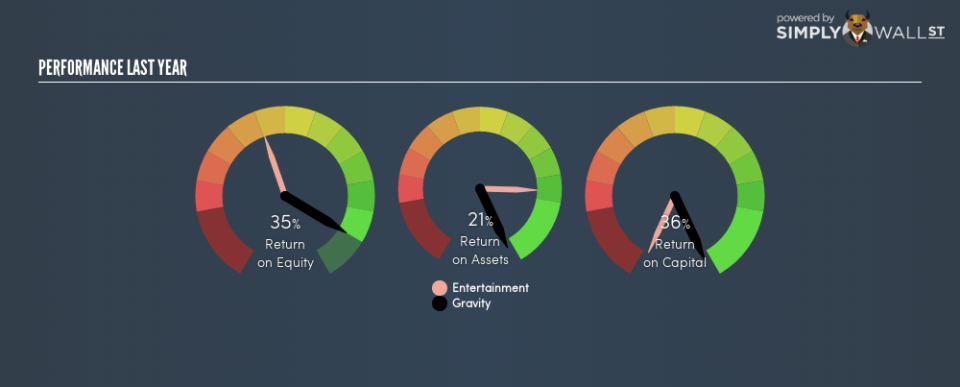Is Gravity Co., Ltd.’s (NASDAQ:GRVY) 36% ROCE Any Good?

Want to participate in a short research study? Help shape the future of investing tools and you could win a $250 gift card!
Today we are going to look at Gravity Co., Ltd. (NASDAQ:GRVY) to see whether it might be an attractive investment prospect. In particular, we’ll consider its Return On Capital Employed (ROCE), as that can give us insight into how profitably the company is able to employ capital in its business.
First of all, we’ll work out how to calculate ROCE. Second, we’ll look at its ROCE compared to similar companies. Then we’ll determine how its current liabilities are affecting its ROCE.
Understanding Return On Capital Employed (ROCE)
ROCE is a measure of a company’s yearly pre-tax profit (its return), relative to the capital employed in the business. Generally speaking a higher ROCE is better. Ultimately, it is a useful but imperfect metric. Author Edwin Whiting says to be careful when comparing the ROCE of different businesses, since ‘No two businesses are exactly alike.’
So, How Do We Calculate ROCE?
The formula for calculating the return on capital employed is:
Return on Capital Employed = Earnings Before Interest and Tax (EBIT) ÷ (Total Assets – Current Liabilities)
Or for Gravity:
0.36 = ₩14b ÷ (₩99b – ₩34b) (Based on the trailing twelve months to September 2018.)
Therefore, Gravity has an ROCE of 36%.
Check out our latest analysis for Gravity
Is Gravity’s ROCE Good?
ROCE can be useful when making comparisons, such as between similar companies. In our analysis, Gravity’s ROCE is meaningfully higher than the 9.9% average in the Entertainment industry. We would consider this a positive, as it suggests it is using capital more effectively than other similar companies. Setting aside the comparison to its industry for a moment, Gravity’s ROCE in absolute terms currently looks quite high.
Gravity delivered an ROCE of 36%, which is better than 3 years ago, as was making losses back then. This makes us wonder if the company is improving.
When considering ROCE, bear in mind that it reflects the past and does not necessarily predict the future. ROCE can be misleading for companies in cyclical industries, with returns looking impressive during the boom times, but very weak during the busts. ROCE is only a point-in-time measure. How cyclical is Gravity? You can see for yourself by looking at this free graph of past earnings, revenue and cash flow.
What Are Current Liabilities, And How Do They Affect Gravity’s ROCE?
Short term (or current) liabilities, are things like supplier invoices, overdrafts, or tax bills that need to be paid within 12 months. Due to the way the ROCE equation works, having large bills due in the near term can make it look as though a company has less capital employed, and thus a higher ROCE than usual. To check the impact of this, we calculate if a company has high current liabilities relative to its total assets.
Gravity has total assets of ₩99b and current liabilities of ₩34b. Therefore its current liabilities are equivalent to approximately 34% of its total assets. Gravity’s ROCE is boosted somewhat by its middling amount of current liabilities.
Our Take On Gravity’s ROCE
Still, it has a high ROCE, and may be an interesting prospect for further research. You might be able to find a better buy than Gravity. If you want a selection of possible winners, check out this free list of interesting companies that trade on a P/E below 20 (but have proven they can grow earnings).
For those who like to find winning investments this free list of growing companies with recent insider purchasing, could be just the ticket.
To help readers see past the short term volatility of the financial market, we aim to bring you a long-term focused research analysis purely driven by fundamental data. Note that our analysis does not factor in the latest price-sensitive company announcements.
The author is an independent contributor and at the time of publication had no position in the stocks mentioned. For errors that warrant correction please contact the editor at editorial-team@simplywallst.com.

